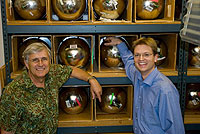Oct 23 2008
A powerful greenhouse gas is at least four times more prevalent in the atmosphere than previously estimated, according to a team of researchers at Scripps Institution of Oceanography at UC San Diego.
 Scripps geoscientists Ray Weiss (green shirt) and Jens Muehle amid collection cylinders used to collect air samples from a variety of locations around the world. Scripps Institution of Oceanography, UC San Diego
Scripps geoscientists Ray Weiss (green shirt) and Jens Muehle amid collection cylinders used to collect air samples from a variety of locations around the world. Scripps Institution of Oceanography, UC San Diego
Using new analytical techniques, a team led by Scripps geochemistry professor Ray Weiss made the first atmospheric measurements of nitrogen trifluoride (NF3), which is thousands of times more effective at warming the atmosphere than an equal mass of carbon dioxide.
The amount of the gas in the atmosphere, which could not be detected using previous techniques, had been estimated at less than 1,200 metric tons in 2006. The new research shows the actual amount was 4,200 metric tons. In 2008, about 5,400 metric tons of the gas was in the atmosphere, a quantity that is increasing at about 11 percent per year.
"Accurately measuring small amounts of NF3 in air has proven to be a very difficult experimental problem, and we are very pleased to have succeeded in this effort," Weiss said. The research will be published Oct. 31 in Geophysical Research Letters, a journal of the American Geophysical Union (AGU).
Emissions of NF3 were thought to be so low that the gas was not considered to be a significant potential contributor to global warming. It was not covered by the Kyoto Protocol, the 1997 agreement to reduce greenhouse gas emissions signed by 182 countries. The gas is 17,000 times more potent as a global warming agent than a similar mass of carbon dioxide. It survives in the atmosphere about five times longer than carbon dioxide. Current NF3 emissions, however, contribute only about 0.15 percent of the total global warming effect contributed by current human-produced carbon dioxide emissions.
Nitrogen trifluoride is one of several gases used during the manufacture of liquid crystal flat-panel displays, thin-film photovoltaic cells and microcircuits. Many industries have used the gas in recent years as an alternative to perfluorocarbons, which are also potent greenhouse gases, because it was believed that no more than 2 percent of the NF3 used in these processes escaped into the atmosphere.
The Scripps team analyzed air samples gathered over the past 30 years, working under the auspices of the NASA-funded Advanced Global Atmospheric Gases Experiment (AGAGE) network of ground-based stations. The network was created in the 1970s in response to international concerns about chemicals depleting the ozone layer. It is supported by NASA as part of its congressional mandate to monitor ozone-depleting trace gases, many of which are also greenhouse gases. Air samples are collected at several stations around the world. The Scripps team analyzed samples from coastal clean-air stations in California and Tasmania for this research.
The researchers found concentrations of the gas rose from about 0.02 parts per trillion in 1978 to 0.454 parts per trillion in 2008. The samples also showed significantly higher concentrations of NF3 in the Northern Hemisphere than in the Southern Hemisphere, which the researchers said is consistent with its use predominantly in Northern Hemisphere countries. The current observed rate of increase of NF3 in the atmosphere corresponds to emissions of about 16 percent of the amount of the gas produced globally.
In response to the growing use of the gas and concerns that its emissions are not well known, scientists have recently recommended adding it to the list of greenhouse gases regulated by Kyoto.
"As is often the case in studying atmospheric emissions, this study shows a significant disagreement between 'bottom-up' emissions estimates and the actual emissions as determined by measuring their accumulation in the atmosphere," Weiss said. “From a climate perspective, there is a need to add NF3 to the suite of greenhouse gases whose production is inventoried and whose emissions are regulated under the Kyoto Protocol, thus providing meaningful incentives for its wise use.”
“This result reinforces the critical importance of basic research in determining the overall impact of the information technology industry on global climate change, which has already been estimated to be equal to that of the aviation industry,” added Larry Smarr, director of the California Institute for Telecommunications at UCSD, who was not involved in the Scripps study.
Michael Prather is a UC Irvine atmospheric chemist who predicted earlier this year that based on the rapidly increasing use of NF3, larger amounts of the gas would be found in the atmosphere. Prather said the new Scripps study provides the confirmation needed to establish reporting requirements for production and use of the gas.
“I’d say case closed. It is now shown to be an important greenhouse gas,” said Prather, who was not involved with the Scripps study. “Now we need to get hard numbers on how much is flowing through the system, from production to disposal.”
Co-authors of the paper are Scripps researchers Jens Mühle, Peter Salameh and Christina Harth.